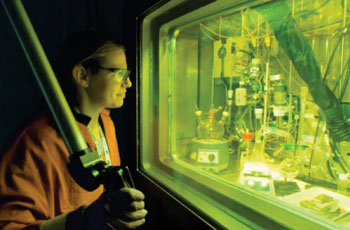Fast Neutrons Help Produce Medical Isotopes
By MedImaging International staff writers
Posted on 21 Jun 2015
An innovative process is being used to create a stable commercial source of molybdenum radioisotopes, widely used in diagnostic imaging.Posted on 21 Jun 2015
Developed by researchers at Argonne National Laboratory (ANL; Lemont, IL, USA), in cooperation with SHINE Medical Technologies (Monona, WI, USA) the process uses fast neutrons to bombard an aqueous solution of low enriched uranium (LEU), creating fission products that include molybdenum-99 (Mo-99), the parent isotope of technetium-99m (Tc-99m), a radioactive tracer element used in more than 40 million medical diagnostic procedures each year in the United States alone.

Image: Chemist Amanda Youker purifying molybdenum-99 (Photo courtesy of Wes Agresta/ ANL).
The isotope is created when Mo-99 spontaneously decays through the release of a beta particle from its nucleus. Because of its unstable nature, Mo-99 does not occur naturally and is traditionally produced using highly enriched uranium (HEU) in nuclear reactors. Mo-99 is also not produced in the United States, leaving the country to rely on isotope supply from international sources, including a Canadian research reactor that will cease regular production next year, which will reduce the global supply.
The SHINE process is easier to implement, since it involves the bombardment of a LEU uranyl sulfate solution with fast neutrons generated on-site in the ANL linear accelerator. The LEU breaks down after bombardment into hundreds of different isotopes, including Mo-99, which is the result of six percent of the fissions created during the process. The Mo-99 must then be separated from the other fission products before it can be transported for use.
“The development of techniques for domestic production of Mo-99 is a critical national priority and one fully supported by our work at Argonne,” said George Vandegrift, PhD, an ANL distinguished fellow who leads the Mo-99 development efforts. “Millions of patients each year rely on Mo-99 for life-saving diagnostic procedures, but the stability and safety of that supply is threatened by a variety of factors.”
Tc-99m is used in about 85% of all medical imaging procedures worldwide. It is currently made in reactors in Canada, the Netherlands, Belgium, France, Australia, and South Africa.
Related Links:
Argonne National Laboratory
SHINE Medical Technologies






 Guided Devices.jpg)







